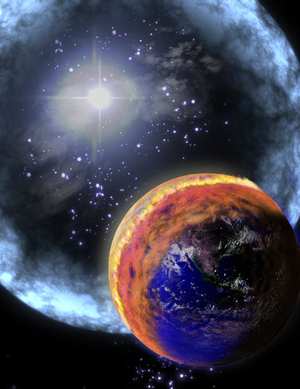Gamma-Ray Bursts Determine Potential Locations for Life
A gamma-ray burst (GRB) is an intense flash of radiation from a dying star that could damage or eliminate life on a planet light years away. A pair of astrophysicists has now analyzed the latest astronomical data to update previous estimates of the likelihood that a GRB affected life on Earth. They found that there’s a 60% chance that a GRB caused an extinction-level event within the past billion years. Looking beyond Earth, the team found that life is more likely to appear in the outer regions of a galaxy, where GRBs are less common, and that GRBs may have made much of the Universe unfriendly to life until about 5 billion years ago.
A GRB releases as much energy in a few seconds as the Sun does in its lifetime. The majority of bursts are the long-duration kind, which arise from a type of supernova that shoots out a pair of powerful jets of material and radiation. If Earth were close enough to a GRB, researchers estimate that the gamma radiation could ionize the upper atmosphere, which would destroy the ozone layer and lead to months without ultraviolet shielding, ensuring death to practically all life on Earth’s surface [1]. Several scientists have explored the possibility of a GRB-induced extinction.
However, some astrophysicists have argued that our Galaxy’s relatively high concentration of metals and other heavy elements suppresses the threat from GRBs [2]. That’s because long-duration GRBs tend to appear in so-called low metallicity galaxies, which have small amounts of the elements heavier than hydrogen and helium. Theories suggest that low metallicity galaxies produce more of the fast-rotating, high-mass stars that are thought to explode as GRBs.
But observations over the past decade have given astronomers a more complete picture of the GRB population, suggesting that they do appear in high-metallicity galaxies like ours but with somewhat lower probability. Using recent data on GRBs and the metallicity of their host galaxies, Tsvi Piran of the Hebrew University in Jerusalem and Raul Jimenez from the University of Barcelona in Spain have now estimated that the GRB rate in our Galaxy is about one-tenth that of the average rate in the Universe. Dividing up GRBs by their energies, they found that our Galaxy experiences one of the larger GRBs (above 1052 ergs of energy) every billion years or so, with smaller bursts occurring more frequently.
Piran and Jimenez estimate that a large GRB could produce an extinction-level event at a distance of 5000 light years, whereas smaller bursts would need to be closer. The researchers found that there was a 60% chance we were hit in the past 1 billion years or a 90% chance if one looks back 5 billion years—consistent with previous estimates based on preliminary models of GRBs. It’s possible, then, that a nearby GRB could have caused one of the mass extinctions recorded in the fossil record. In fact, the Ordovician extinction, which occurred around 440 million years ago, had certain signatures of a GRB-induced event, such as a greater extinction rate among surface-dwelling marine life as compared with bottom-dwellers [3].
Piran and Jimenez also considered the danger for other planets. They argue that the higher stellar density in the inner part of our Galaxy increases the likelihood of a nearby GRB for planets in that region. The researchers speculate that life in our Galaxy is probably restricted to distances greater than 10,000 light years from the galactic center (the galactic radius is about 50,000 light years). Piran thinks this might explain why we Earthlings are located in the outskirts of the Galaxy, at about 27,000 light years from the center. In earlier epochs, when galaxies were smaller, the low-density outskirts were not far enough away from the center to provide much protection from GRBs, Piran and Jimenez say. This problem, combined with the higher frequency of GRBs in the past, led them to speculate that life would have had trouble getting started in the Universe until 5 billion years ago.
Adrian Melott from the University of Kansas says the new estimates sound right and that the work breaks new ground by discussing locations that are inhospitable to life. But he points out that this is a rather limited view of what life is. “Places like Enceladus or Europa [moons of Saturn and Jupiter], with probable oceans under an ice layer, would be nearly immune to the effects of a GRB,” Melott says.
This research is published in Physical Review Letters.
–Michael Schirber
Michael Schirber is a Corresponding Editor for Physics Magazine based in Lyon, France.
References
- B. C. Thomas, A. L. Melott, C. H. Jackman, C. M. Laird, M. V. Medvedev, R. S. Stolarski, N. Gehrels, J. K. Cannizzo, D. P. Hogan, and L. M. Ejzak, “Gamma‐Ray Bursts and the Earth: Exploration of Atmospheric, Biological, Climatic, and Biogeochemical Effects,” Astrophys. J. 634, 509 (2005)
- K. Z. Stanek et al. “Protecting Life in the Milky Way: Metals Keep the GRBs Away,” Acta Astron. 56, 333 (2006), http://acta.astrouw.edu.pl/Vol56/n4/a_56_4_3.html
- A. L. Melott, B. S. Lieberman, C. M. Laird, L. D. Martin, M. V. Medvedev, B. C. Thomas, J. K. Cannizzo, N. Gehrels, and C. H. Jackman, “Did a Gamma-Ray Burst Initiate the Late Ordovician Mass Extinction?” Int. J. Astrobiol. 3, 55 (2004)
More Information
The Swift Gamma-Ray Burst Mission
Gamma Ray Burst Primer (PDF from NASA)





